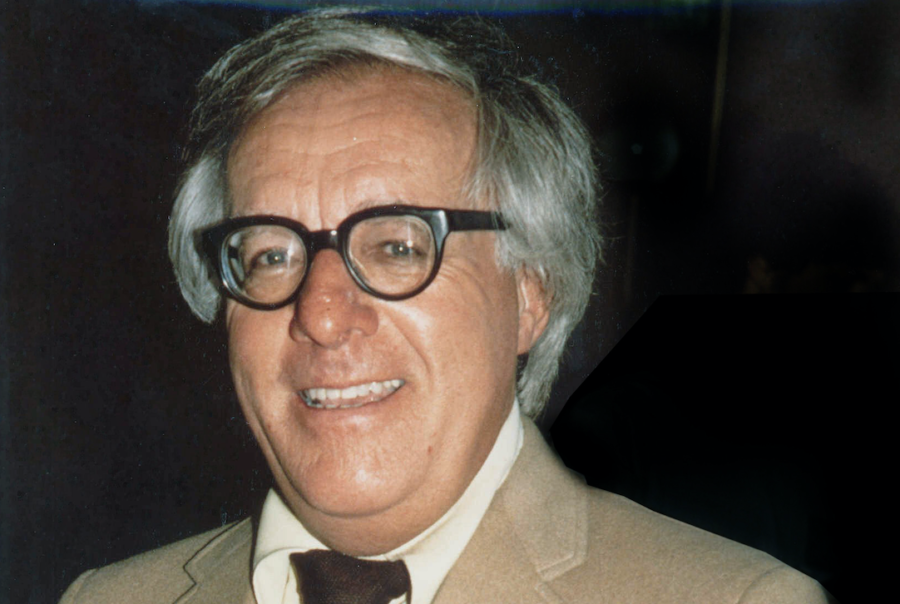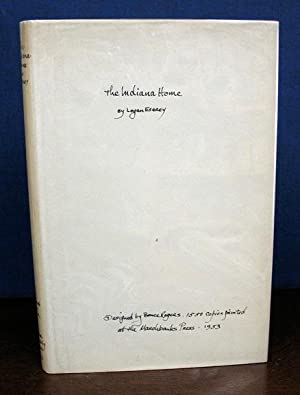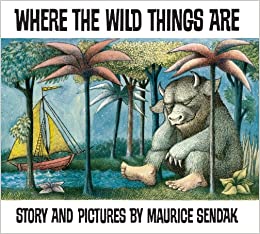The creator of Middle-earth, J.R.R. Tolkien, wasn’t just a master weaver of tales; he was also a man of great depth and integrity. His life, filled with unique anecdotes and profound choices, is as engaging as his novels. Here’s a peek into seven lesser-known moments from Tolkien’s life. 1. A Brave Response to Dark Times: … Continue reading Tolkien Tales: 7 Lesser-Known Stories about the Mastermind of Middle-earth
Bradbury’s Fire: The Playboy Debut of Fahrenheit 451
In 1953, the iconic novel Fahrenheit 451 was acquired by Hugh Hefner. This renowned work of Ray Bradbury was subsequently published across the second, third, and fourth issues of Playboy magazine.
Novella vs Novel
A piece of fiction that falls within the word count range of 20,000 to 49,999 is typically referred to as a novella. On the other hand, once the word count of a book reaches 50,000, it is generally classified as a novel.
An author created a 1000…
An author created a 1000 page book that is made up of a single run on sentence.
The post An author created a 1000… appeared first on Crazy Facts.
Benjamin Franklin published a yearly…
Benjamin Franklin published a yearly almanac called Poor Richard’s Almanack. The publication was extremely popular, selling 10,000 copies per year, making Franklin rich. In 1735, upon the death of his brother, Franklin sent 500 copies to his widow so she could make money selling them.
The post Benjamin Franklin published a yearly… appeared first on Crazy Facts.
Ray Bradbury wrote the first draft…
Ray Bradbury wrote the first draft of Fahrenheit 451 on a typewriter in UCLA Library’s basement that cost 10 cents for 30 minutes. 9 days and $9.80 later he had a short story titled ‘ The Fireman’ that was later expanded into Fahrenheit 451.
The post Ray Bradbury wrote the first draft… appeared first on Crazy Facts.
In 1953, a member of the Indiana Textbook…
In 1953, a member of the Indiana Textbook Commission attempted to ban teaching Robin Hood in schools stating “there is a Communist directive in education now to stress the story of Robin Hood, they want to stress it because he robbed the rich and gave it to the poor. That’s the Communist line.”
The post In 1953, a member of the Indiana Textbook… appeared first on Crazy Facts.
The book ‘Where the Wild Things Are’…
The book ‘Where the Wild Things Are’ created controversy when it was first published because many parents and people thought that the wild things looked too scary for children.
The post The book ‘Where the Wild Things Are’… appeared first on Crazy Facts.
Lord of the Rings Fan Offers Unexpected Analysis of Boromir’s Demise
JRR Tolkien’s Lord of the Rings trilogy, along with The Hobbit, have inspired a cult following among readers and movie-goers.
Personally, I enjoyed the movies but never finished the books. (I’m sorry  )
)
And I haven’t joined my mother in semi-annual rewatching events.
So when a Tumblr user wrote an essay about the death of Boromir my first thought was which one was that again? (Don’t stone me  )
)
And my second thought was is he the one that’s in EVERYTHING? (I looked it up. Sean Bean, and yes.)
Boromir. pic.twitter.com/WEXkGroHJ9
— Middle Earth – Behind the Scenes (@theoneringbts) June 27, 2021
But a lengthy, viral thread from Tumblr made me want to go back and rewatch, and give Boromir his due.
SPOILER ALERT – Boromir dies. And the topic of this particular essay is the reason why his death gets more meaningful the older we get.
The user @letmetellyouaboutmyfeels believes this is because Boromir is the every man, the character we may not have aligned ourselves to as children, but who we most identify with as adults.
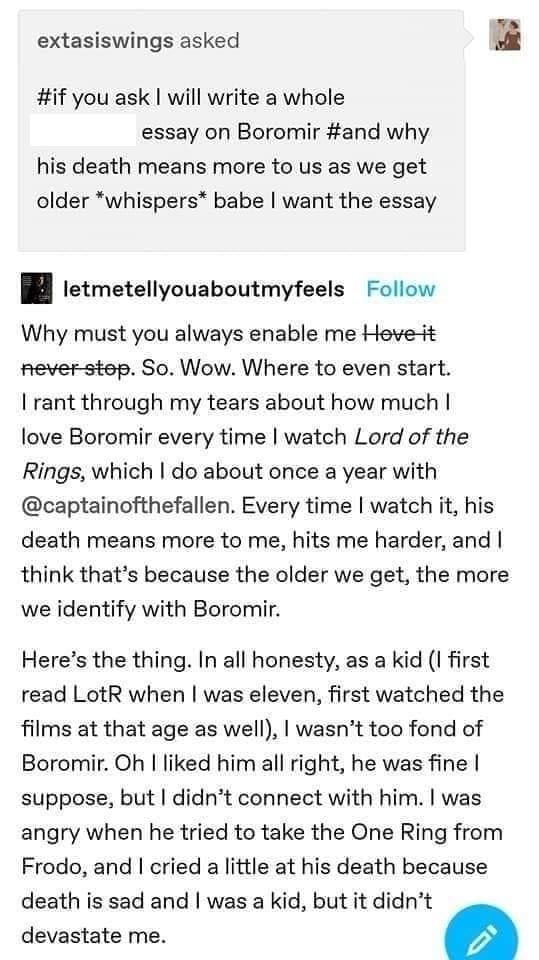
Image credit: Tumblr via Cheezburger
It’s an interesting critical analysis worthy of any film studies or literature class, but the user didn’t stop there.
They explained why life beats you down until you are more aligned with the every man than your hero Aragorn.
Boromir/Aragorn pic.twitter.com/5gt8FD6Lx0
— BlueberryMuffinThief (@anon_blueberry) June 28, 2021
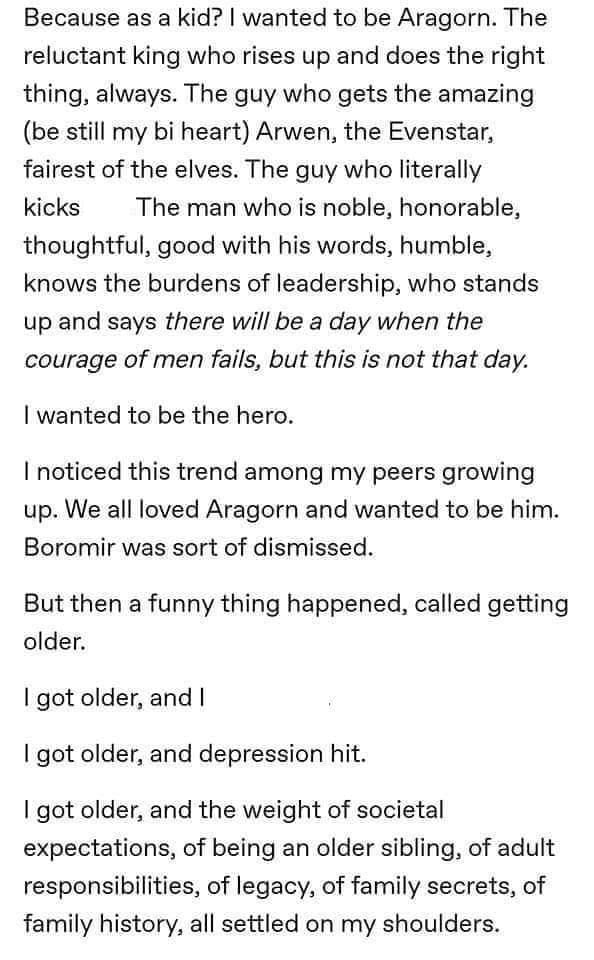
Image credit: Tumblr via Cheezburger
The user, @letmetellyouaboutmyfeels, has lived to see some stuff, it seems.
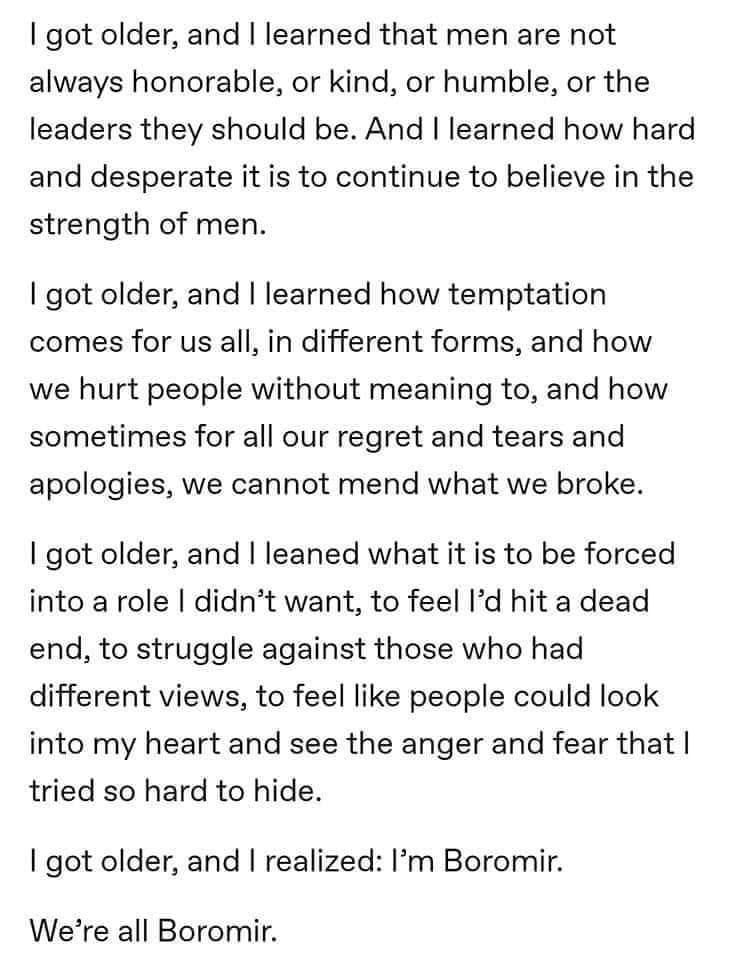
Image credit: Tumblr via Cheezburger
And when it comes to Tolkien, they know their stuff.
Tolkien embraced the archetype. There’s a reason we all love Aragorn, and it’s not just because of Viggo Mortensen and his beautiful face.
Aragorn from Lord of the Rings is literally my ideal man in every way pic.twitter.com/9UfpFFyYT1
— W⃣ h⃣ i⃣ t⃣ (@whitneykoehn) June 29, 2021
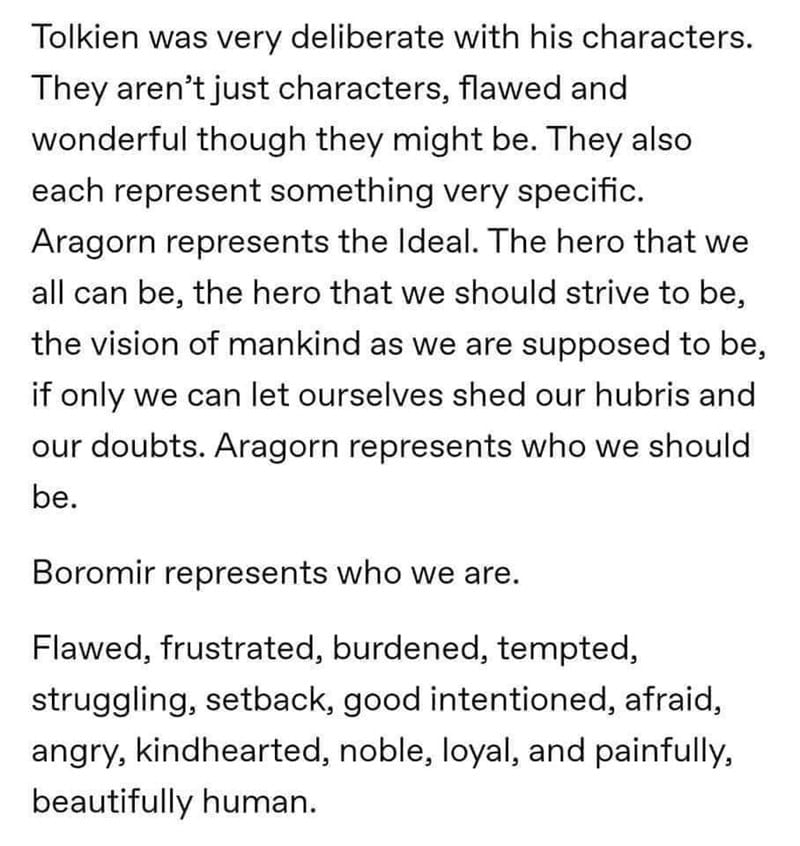
Image credit: Tumblr via Cheezburger
But Boromir served an integral part of the story. He has agency.
Without him, as with any great character, the story would have turned out differently, maybe for the better, maybe for the worse.
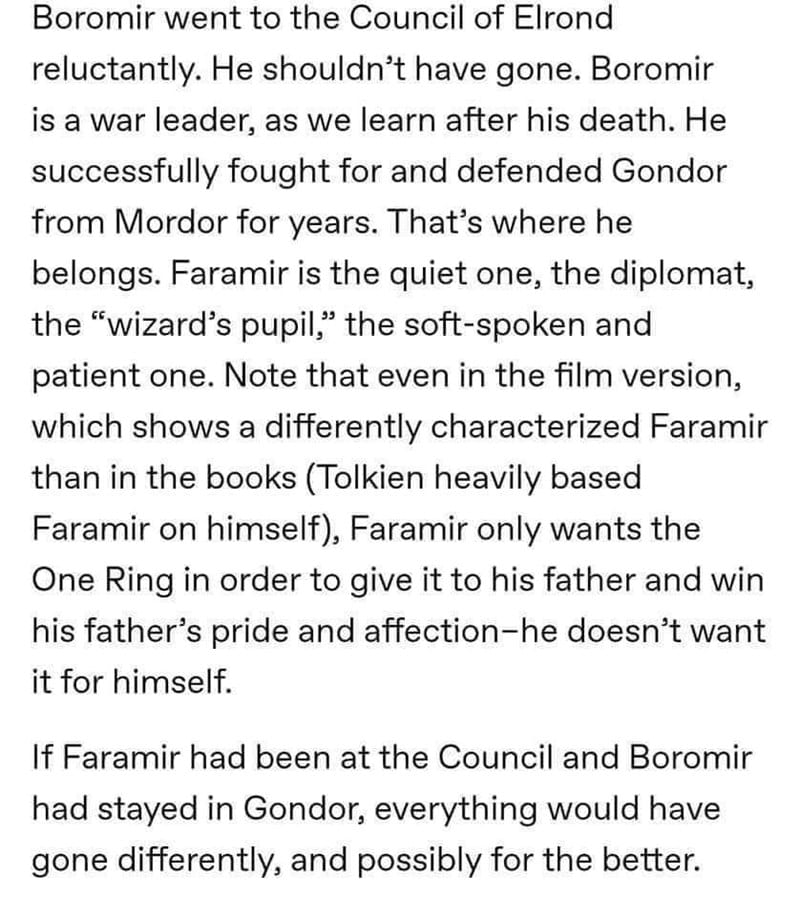
Image credit: Tumblr via Cheezburger
Then @letmetellyouaboutmyfeels brings it all back into context of modern life.
They explain how like Boromir we tend to be–stuck in cycles of expectation, trying, and failing, and just being human.
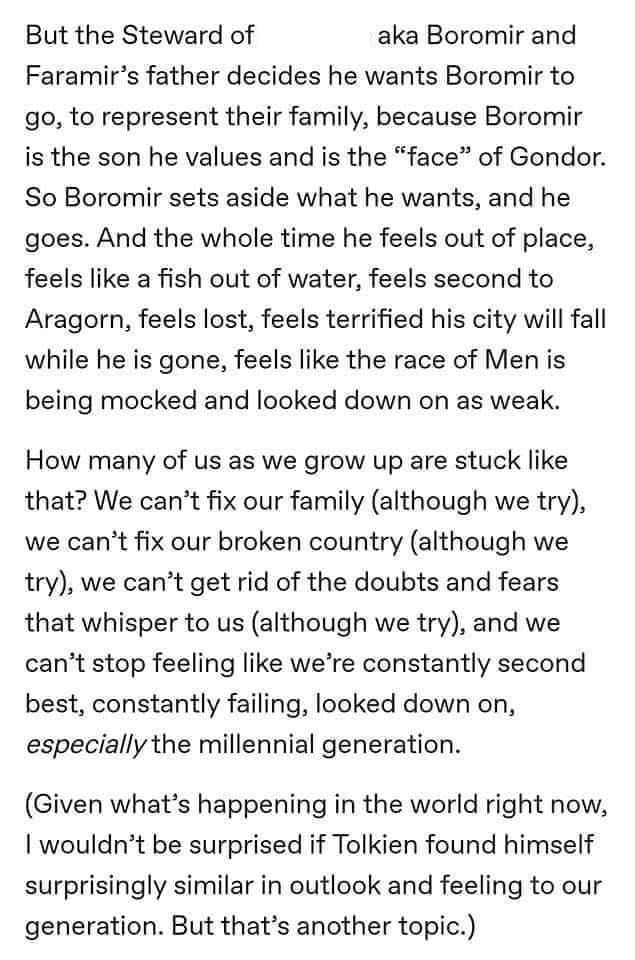
Image credit: Tumblr via Cheezburger
But, they also point out, that there is strength in Boromir’s frailty, in his humanity.
Because he admits when he fails. And he tries and he tries and he tries again.
Just like we all do–or should–or strive to.
O, Boromir. My brother. https://t.co/Nmuz7h2L2L pic.twitter.com/NKW5bGfW3S
— george (@9e0rr9e) July 1, 2021
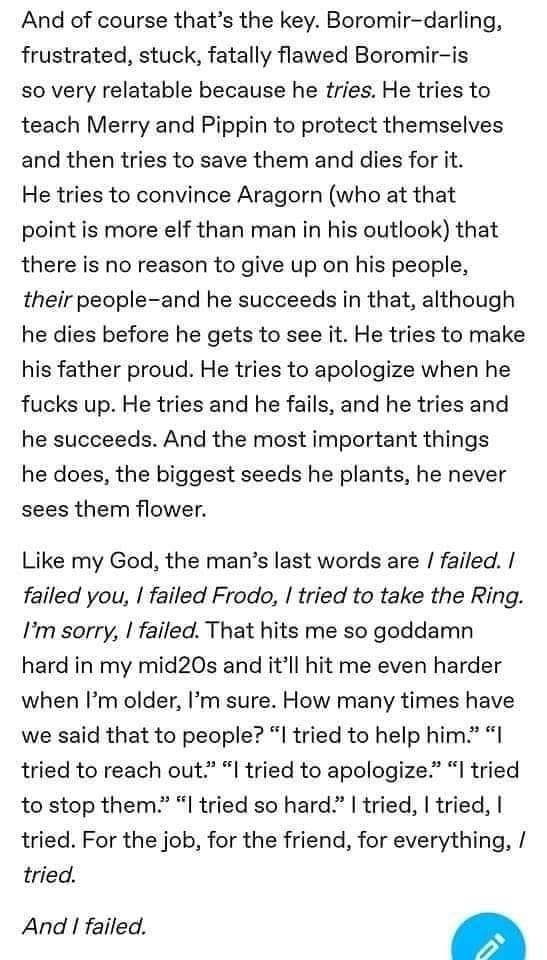
Image credit: Tumblr via Cheezburger
@letmetellyouaboutmyfeels brings it all full circle, showing how Boromir was instrumental, before his death, in handing things off to Aragorn.
They describe how even in his last act, Boromir–human that he was–ensured the final success of the Fellowship.

Image credit: Tumblr via Cheezburger
They write about the evolution of their heroes, from childhood to teenage-dom to adulthood, and how in adulthood we lose sight of the ideal, and begin to focus on our own humanity and failures.
I love Boromir. He’s so perfectly flawed and, in many ways, far more interesting than the other purely good characters. pic.twitter.com/0uE3lkDfpX
— Bree wants you to #VACCINATE (@breethemidwife) June 28, 2021

Image credit: Tumblr via Cheezburger
They point out again, all of the good that Boromir did, and all of the ways that Aragorn and the others might not have succeeded without him.
Although he was his own worst critic, as are we all, Boromir was not a complete failure. He had success too.
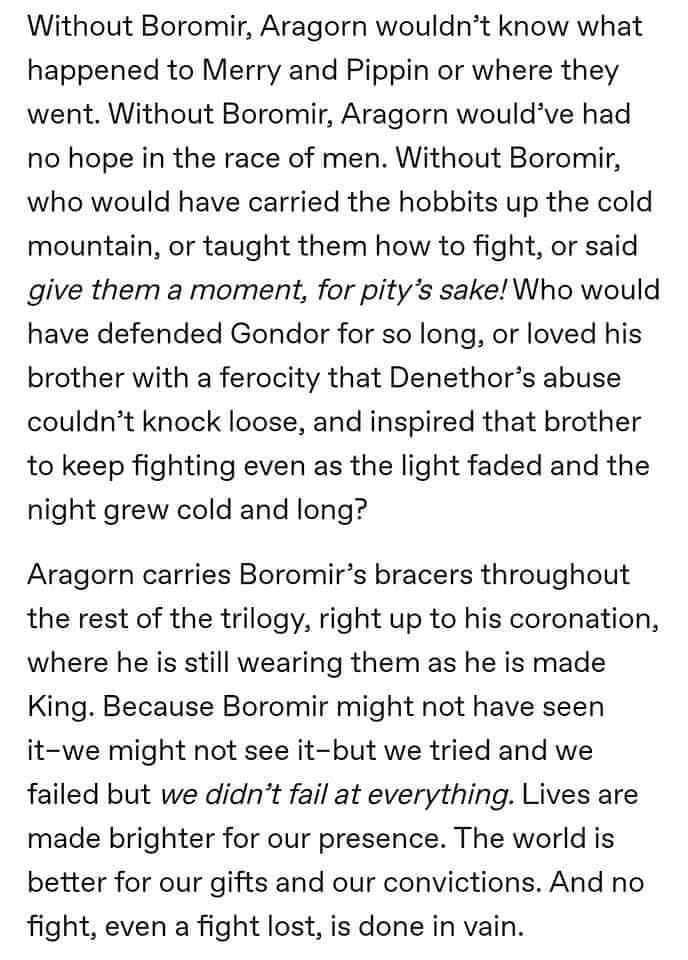
Image credit: Tumblr via Cheezburger
And that is why his death might hit much harder now than it did as a child.
As a kid, you were probably thinking “Darn, but thank goodness it wasn’t Aragorn! He can still save the day!”
As an adult, you look at Boromir, and you just might see yourself.

Image credit: Tumblr via Cheezburger
Watching Boromir die hurts every time. He is the best of us and the worst of us. #lockdownLoTR pic.twitter.com/okf4ei9bWh
— Grimdark Magazine (@AdrianGdMag) June 26, 2021
The essay took quite a turn when you realize that it was written by, not someone in their 40s or 50s, but by someone mid 20s who has seen a lot of life.
But there’s a lot of truth in it. What about you? Does Boromir’s death get you every time?
The post Lord of the Rings Fan Offers Unexpected Analysis of Boromir’s Demise appeared first on UberFacts.
6 Facts About “The Monster At The End Of This Book”
If you have kids or have ever had occasion to read books to children, there’s a good chance you’ve come across The Monster at the End of This Book.
First published in 1971, author Jon Stone and illustrator Michael Smollin struck gold, and you’d be hard pressed to find a children’s library that doesn’t contain at least one copy.
It’s sold more than 20 million copies worldwide – from the title pages, which freak Grover out, all the way to the hilarious conclusion, we know it cover-to-cover.
Still, there are probably a few things you don’t know about the book – we think the six facts below or definitely worth sharing!
6. It only took a few hours to write it.
View this post on Instagram
The Washington Post claims Jon Stone wrote the book – all 350 words – on a legal pad as he flew home to California in late 1970 or early 1971. He hated flying and would write to ease his anxiety…in this case, by giving his character intense anxiety.
Once on the ground he showed the manuscript to Christopher Cerf, who was helping develop books and other products to fund Sesame Street.
Cerf thought Stone was onto something, and as someone who had worked with several famous children’s authors (including Dr. Suess), he knew what he was talking about.
5. The author was one of the architects of Sesame Street.
View this post on Instagram
As for Stone, he started with CBS after graduating from the Yale School of Drama in 1955. Prior to the debut of Sesame Street he’d written for Captain Kangaroo, and after being recruited by co-creator Joan Ganz, Stone was tasked with assembling Sesame Street’s original, inclusive cast.
He also developed some of its best-known characters, wrote the pilot episode, and helped bring Jim Henson on board.
4. The illustrator was a decorated war veteran.
View this post on Instagram
Illustrator Michael Smollin was born to immigrant parents in 1925 as they fled the chaos of WWI. Smollin himself fought in WWII, earning a Purple Heart for his actions during the Battle of the Bulge.
He was a commercial illustrator for many years with a huge and important client list that included Milton Bradley, TV Guide, and Time magazine.
3. This book has influenced many others.
View this post on Instagram
From award-winning thriller authors like Brad Parks, who said “There is a monster at the end of all of my novels, and I want you to feel this unbearable compulsion to turn pages and find out what it is,” to science fiction novelists like David Burr Gerrard, who say The Monster at the End of This Book taught him what literature “could and should do,” Stone’s small tale has inspired giants.
Riley Sager, New York Times bestselling author, expounded on why they believe the book is the force behind so many careers.
“I suspect The Monster at the End of This Book is one of those influences many thriller writers have in common, even if we’re not aware of it. It was certainly my first encounter with suspense – knowing from the title that there’s a monster waiting for us on the last page and feeling both dread and delightful anticipation as I made my way through the book – and of experiencing a twist ending. In hindsight, The Monster at the End of This Book acts as a sly commentary on the sometimes cruel curiosity humans possess. Grover implores us not to turn the page. Yet we do. Every damn time. Which, in a twisted way, makes us monstrous as well.”
2. The Muppet who became Grover first appeared on The Ed Sullivan Show in 1967.
In the 1967 Christmas Eve episode of The Ed Sullivan Show, a green Muppet with an orange nose – a proto-Grover known as Gleep – starred in a sketch where he and a crew of burglars set about disrupting work in Santa’s workshop.
Grover became a regular on Sesame Street three years later, in 1970, one year before The Monster at the End of This Book was published – blue fur, pink nose, all lovable anxiety and sweet agreeability.
1. The book also inspired many other projects.
Several more Grover books, all created by the team of Stone and Sullivan, were published after The Monster at the End of This Book, and sequels have been published as recently as 2006.
The books has been translated into an award-winning interactive app, which has been downloaded more than half a million times, and in 2013, the official Sesame Street Twitter account warned their followers not to retweet “There is a MONSTER at the End of This Twitter Conversation.”
HBO Max also debuted an animated special called There is a Monster at the End of This Story in late 2020.
This definitely makes me want to read this with my kiddo sooner rather than later?
How many times have you read this book to littles? Drop an educated guess in the comments!
The post 6 Facts About “The Monster At The End Of This Book” appeared first on UberFacts.


